#Suborder: Pleocyemata
Text
Are Prawns Healthy To Eat
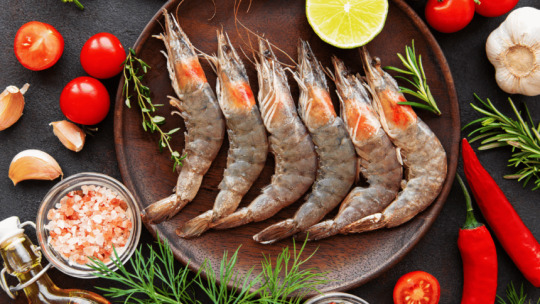
What are prawns?
Are Prawns Healthy: Prawns are small aquatic crustaceans with an exoskeleton and ten legs, belonging to the order of decapods. They are often edible and are especially significant in the fishing industry. The term “prawn” is commonly used in the United Kingdom, Ireland, and Commonwealth nations for large swimming crustaceans or shrimp.
The terms “shrimp” and “prawn” are often used interchangeably, but they refer to different suborders of crustaceans. Shrimp belong to the sub-order Pleocyemata, while prawns belong to the sub-order Dendrobranchiata.
Despite these differences, the terms are often confused or used interchangeably in different countries or regions. The taste and texture of shrimp and prawns can vary, but these differences do not divide along “shrimp” and “prawn” lines. In other words, while shrimp and prawns are not the same, their flavors are similar, making them interchangeable in recipes.
Are Prawns Healthy
Yes, prawns are generally considered healthy. They are a great source of high-quality protein and provide several important vitamins and minerals. Here are some key points about their nutritional value:
– Low in Calories: Prawns are quite low in calories, providing only 84 calories in a 3-ounce serving.
– Rich in Nutrients: They provide more than 9 different vitamins and minerals, including iodine, an important mineral that many people are deficient in.
– High in Protein: Prawns contain 20.4g of protein per 3-ounce serving.
– Omega-3 Fatty Acids: Prawns are also a good source of omega-3 fatty acids.
However, it’s worth noting that prawns are high in cholesterol. A 3-ounce serving contains 161 mg of cholesterol. While this has led to some concerns, research shows that for most people, dietary cholesterol may only have a small impact on blood cholesterol levels. In fact, prawns may help lower bad cholesterol and increase good cholesterol.
As with any food, it’s important to consume prawns as part of a balanced diet. If you have a shellfish allergy, you should avoid prawns.
Are Prawns Healthy For Weight Loss
Yes, prawns can be a healthy choice for weight loss for several reasons:
1. Low in Calories: Prawns are low in calories, making them a good choice for a weight loss diet. About 85 grams of cooked prawns contain only about 101 calories.
2. High in Protein: Prawns are a good source of lean protein, which is essential for weight loss. Proteins take longer to digest, keep you full for a longer period, and thus help in reducing appetite.
3. Low in Fat: Being a lean source of protein, prawns are low in fat with only 0.5 grams of fat per 2-ounce serving.
4. Rich in Omega-3 Fatty Acids: Prawns contain a lot of healthy omega-3 fatty acids, which have been shown to help with weight loss. Omega-3 fatty acids help to boost metabolism, and they also help to reduce inflammation in the body. This can lead to reduced water retention and a decrease in belly fat.
However, it’s important to remember that the way prawns are prepared can significantly affect their nutritional value. For example, grilling or boiling prawns would be a healthier choice than frying them. As always, it’s best to consume prawns as part of a balanced diet. If you have a shellfish allergy, you should avoid prawns.
Prawns Benefits And Side Effects
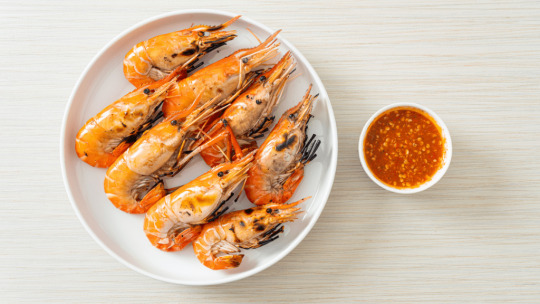
Prawns have several health benefits but also come with some potential side effects. Here’s a summary:
Benefits:
1. High in Protein: Prawns are a high-quality protein source that supports muscle growth and maintenance.
2. Rich in Nutrients: They are rich in several vitamins and minerals, including selenium, which can help prevent the growth of cancer cells.
3. Good for Cardiovascular Health: Prawns have low saturated fat and cholesterol content, along with omega-3 fatty acids that reduce the risk of cardiovascular diseases.
4. Skin Health: The antioxidants present in prawns can help improve skin health.
5. Immune Health: The high zinc level present in prawns can improve immune health.
Side Effects:
1. High in Cholesterol: Prawns have a high cholesterol content, which may contribute to heart disease and stroke risk if consumed in excess.
2. Toxic Content: Prawns may contain some toxic content such as dioxins, PCBs, and other banned chemicals.
3. Digestive Issues: Prawns contain a large quantity of skin, which can be hard to digest and may affect the digestive system.
4. Allergenic: Prawns can cause allergies in some people, leading to stomach problems and diarrhea.
Remember, the way prawns are prepared can significantly affect their nutritional value. For example, grilling or boiling prawns would be a healthier choice than frying them. As always, it’s best to consume prawns as part of a balanced diet. If you have a shellfish allergy, you should avoid prawns.
Read More: -
0 notes
Text


Shrimp and a Hermit Crab! What a pretty shell they’ve made into their home!
#idk what kind#Phylum: Arthropoda#Class: Malacostraca#Order: Decapoda#Suborder: Dendrobranchiata#Suborder: Pleocyemata#Infraorder: Anomura#Superfamily: Paguroidea#Superfamily: Penaeoidea#hermit crabs#shrimp#Crabs#crustaceans
0 notes
Text
Spiny Lobster: Spiny and Clawless but Colorful Nonetheless
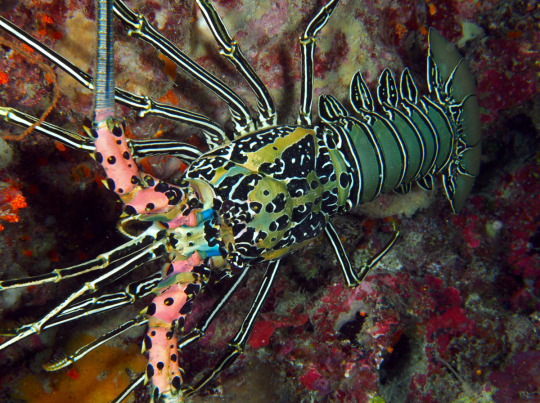
Photo from: Florent’s Guide to the Tropical Reefs
Yes, you read it right! Apparently there exists a lobster (Family Palinuridae) without claws. It may not be the one you’ve exactly imagined when you see those crustaceans whose claws are clamped in an aquarium outside a seafood restaurant but we’re pretty sure these lobsters saved the chef from some pinches. To some punctures? That we don’t know. It is named spiny lobster afterall!
I. Classification
Kingdom: Animalia
Phylum: Arthropoda
Subphylum: Crustacea
Class: Malacostraca
Subclass: Eumalacostraca
Superorder: Eucarida
Order: Decapoda
Suborder: Pleocyemata
Infraorder: Achelata
Family: Panuliridae
Genus: Panulirus
Species: versicolor (Fofonoff et. al. 2018)
II. Distribution: Hi! So my address is just right here..

Photo from: Lavery et. al. 2014
Known as the Painted Spiny Lobster, they are native to the Indo-Pacific waters and are distributed in the Red Sea, South Africa, Southern Japan, Northern Australia, Micronesia, and Polynesia. However, the first non-native occurrence is reported in the Brunswick River, Georgia (Fofonoff et. al. 2018).
III. Anatomy: Pinching for that Body Plan
Extenal Anatomy

The external anatomy of a true lobster (Family Nephropidae) is composed of two parts: The Cephalothorax and the Abdomen as depicted above. The same is true for spiny lobsters but the Paniluridae traversed a different way in the path called evolution.
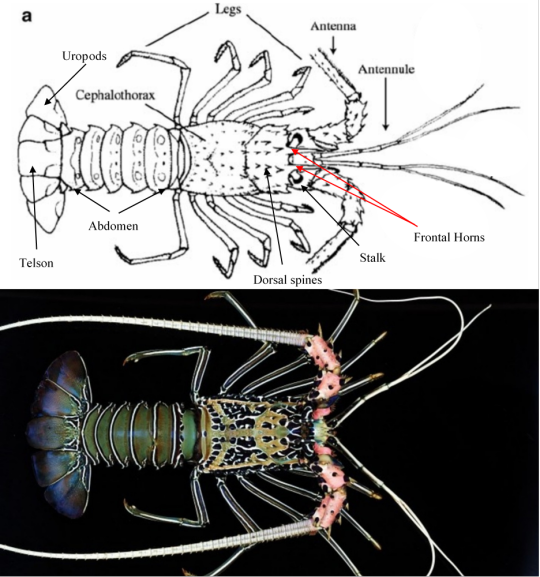
Photo from: Charles Derby 2011 (up) and Nemesis Database Species Summary (down)
So what do true lobsters have that spiny lobsters don’t? Or better yet what makes spiny lobsters unique from other lobsters?
Spiny lobsters lack the prominent claws and rostrum associated with true lobsters and instead have two frontal horns and prominent dorsal spines (Fofonoff et. al. 2018). Its body is tubular in shape with all of its legs not possessing true pincers and the first pair is not enlarged (Tavares). The antennae are cylindrical, enlarged, and longer than its body. The total body length reaches up to 400mm, but the average maximum size is around 300mm. The male spiny lobster tends to be larger than females (Fofonoff et. al. 2018).
Panulirus versicolor’s carapace has a whitish background, with large areas of bluish-black. The abdomen, on the other hand, is predominantly green in color and the telson is a mix of bluish-black and green. The legs are lined with black and blue stripes. The antenna is pinkish-red in the thicker and lower segments and becomes white ringed with black rings in the upper segment (Sutton 2017).

Photo by: Sutton 2017
The following are brief functions of the spiny lobster’s general external anatomy:
Shell: This part is the lobster’s exoskeleton, made from chitin, which serves as a protection for the internal anatomy. However, for the lobster to grow, it sheds its shell in the process called molting.
Antennae and Antennules: The antennae and antennules of the lobster are used as chemoreceptors, which detect odors and chemical signals to help them in locating food, mate, and avoid danger. In spiny lobsters, the antenna is longer than the antennules.
Stalks: For their vision, lobsters have long and stalked compound eyes. Although stalked, their vision is not that excellent, and can only see images in dim light.
Legs: Since they are under Decapoda, they have 10 legs that are used by the animal to navigate its way on the seafloor.
Tail fan: This is the last segment of the lobster. It has a telson as the center tail fin and pairs of uropods at both sides and is used for backward propulsion.
Internal Anatomy
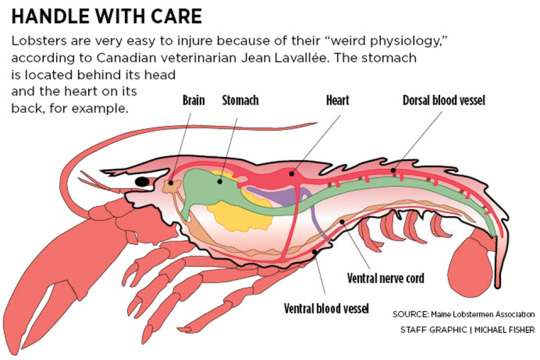
These creatures as a member of the Decapod group have internal organs that are the same as the other species. Its circulatory system is open, unlike humans. They have a single-chambered heart that is composed of muscles and ostia, or openings. Usually, the heart of an adult lobster beats for 50-136 beats per minute.
IV. Reproduction and Life Cycle
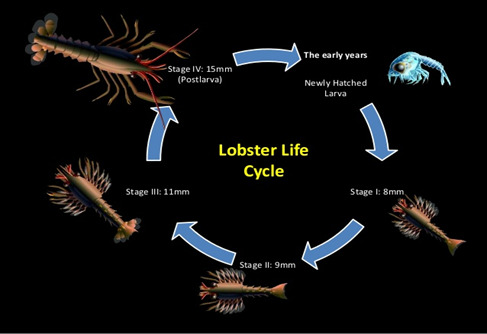
Photo from: Shiran Weerathunga, 2014
A day in a lobster’s life, they reach sexual maturity at the age of 5 to 6 years. The male’s task is to mate with as many female lobsters there is. Usually, they mate to a depth of 50 to 100 feet of water. As they mate, the male will deposit its spermatophore or known as the plaster in the female’s belly. After a while, the female will move to waters less than 30 feet deep, and when she is ready to spawn, she will use the pincers on her fifth walking leg to cut the plaster and fertilize her 80,000 to 800,000 eggs.
These eggs will be deposited under her tail, where she will perform parental duties until they hatch 9 to 10 weeks later. Usually, the larvae are transparent, large, pigmented eyes with long legs, and have little resemblance to adult lobsters. After 7 to 9 months they drift with the currents and eat plankton, after which they go to shallow water and settle at the bottom. Their lifespan is estimated to be 15 years (Cardone 2008; NOAA Fisheries 2020).
Check out this video of spiny lobsters mating!
youtube
and these cute baby lobsters!
youtube
V. Ecology
Habitat
They are found living singly or in groups in shallow water ranging from the low-tide marks up to 15 m depth and often reside in rocky areas, coral reefs, and overhangs that provide them protection (Fofonoff et. al. 2018; Mortiz 2010).

Photo by: Aquapix
Feeding Habit and Predators
Spiny lobsters are nocturnal and carnivore feeders. They even exhibit cannibalism at some point in their lives.They remain hidden in their reef or rock shelters called dens during the day and hunt during night for a variety of mollusks, shrimp, crabs, worms, and sea urchins (Sutton 2017). They use their strong legs to pry open their prey. Meanwhile, spiny lobsters are a delicacy not only to humans but octopus, groupers, and trigger fishes as well.
Be fascintaed with this video on how spiny lobsters protect themselves from a trigger fish.
youtube
VI. Relationship with Humans
Ornamental organisms
The juvenile painted spiny lobster displays a vibrant and attractive coloration of blue and purple body with white antennae which has attracted the market of tropical marine aquarium trade (Fofonoff et. al. 2018).

Photo by: Rokus Groeneveld & Sanne Rejis
For consumption
Spiny lobsters in general are eaten and are regarded as a delicacy. The meat located at the lobster’s abdomen proved to be very tasty and chewy.
youtube
While the lobster is a rich source of copper and selenium, it contains very high cholesterol, thus, it should be eaten in a regulated manner. Additionally, lobster contains zinc, phosphorus, vitamin B12, magnesium, vitamin E, and a small amount of omega-3 fatty acids (Ware 2018).
For livelihood
As of 2011, Panulirus spp. farming has not been reported in the last years to FAO but the species are cultured in Vietnam, Indonesia, Malaysia, and Philippines (Clive and Shanks 2009). Philippine waters are a natural resource of seeds for lobster farming and so there is a regional trade in peuruli and juveniles to establish spiny lobster farming.

Photo from: Mercator Media Ltd 2020
However, an article published in 2018 says that BFAR will bring the lucrative lobster culture to poor communities in Eastern Visayas by providing the cages and feeds to the beneficiaries (Meniano 2018). According to BFAR, the lobster culture is very ideal not only because of the strong demand from China and Taiwan but also because it is very expensive (4,000 per kilogram) (Meniano 2018).
VII. Did you know?
1. Lobsters pee out of their heads. While their anus is located posteriorly, their bladder is found under its brain and the opening is located at the base of their antennae, or just under their eyes!

2. The female lobster takes "her clothes off" to mate. Female lobsters “take off” their shells during molting and it is in this process that they decide to mate as well.

3. Lobsters have two stomachs. To make things even more weird, the first stomach located on its head has teeth! It functions to crush food and the second aids in digestion and is located at the abdomen.
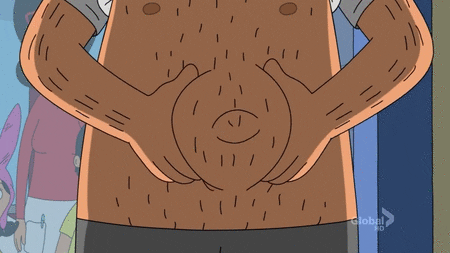
4. Lobsters can detach one of their limbs in an emergency. Don’t worry, they are able to regrow it during the molting process.(Yes, the organism in the video is a crayfish but the mechanism is the same with their lobster cousins!)
youtube
5. In the 17th century, lobster was anything but a delicacy. In fact, a field guide by Motoh from Southeast Asian Fisheries Development Center in 1980 said that the spiny lobster sells for about ₱55/kg in Manila and ₱40/kg in local areas! Now, as stated above, it costs ₱4,000/kg!

Photo from: Creative Tourist (Courtesy of Barnsley Museum)
6. The blood is known as the hemolymph and is color blue due to the presence of Copper.

Photo from: @WhatTheFFacts on twitter
VIII. References
American Lobster. (2020). Overview of Homarus americanus: The American Lobster. Retrieved November 9, 2020, from, http://www.parl.ns.ca/lobster/overview.htm
Cardone, B. (2008). The Lifecycle of Spiny Lobsters - California Diving News. Retrieved November 10, 2020, from https://cadivingnews.com/the-lifecycle-of-spiny-lobsters/
Clive, J., Shanks, S. (2009). Requirements for the aquaculture of Panulirus ornatus in Australia. Australian Centre for International Agricultural Research, 98-109
Fofonoff PW, Ruiz GM, Steves B, Simkanin C, & Carlton JT. (2018). National Exotic Marine and Estuarine Species Information System. Retrieved November 9, 2020, from, http://invasions.si.edu/nemesis/
Lavery S.D., Farhadi A., Farhamand H., Chan T.Y., Azhdehakoshpour A., Thakur V., Jeffs, A. (2014). Evolutionary Divergence of Geographic Subspecies within the Scalloped Spiny Lobster
Panulirus homarus (Linnaeus 1758). Retrieved November 9, 2020, from,DOI: 10.1371/journal.pone.0097247
Meniano, S. (2018). BFAR eyes lobster farms in 3 Eastern Visayas provinces. Retrieved from Philippine News Agency: https://www.pna.gov.ph/articles/1042610#:~:text=Lobster%20culture%20is%20very%20ideal,high%20preference%20for%20live%20lobsters.&text=A%20fishermen%20can%20raise%20up%20to%20100%20lobster%20juveniles%20in%20a%20cage.
Mortiz. (2010). Family Palinuridae - spiny lobsters. Retrieved from SealifeBase: https://www.sealifebase.ca/Summary/FamilySummary.php?ID=13
Motoh, H. (1980). FIELD GUIDE FOR THE EDIBLE CRUSTACEA OF THE PHILIPPINES. Iloilo, Philippines: SOUTHEAST ASIAN FISHERIES DEVELOPMENT CENTER (SEAFDEC) .
NOAA fisheries. (2020). Caribbean Spiny Lobster. Retrieved November 10, 2020, from https://www.fisheries.noaa.gov/species/caribbean-spiny-lobster#:~:text=Spiny%20lobsters%20may%20live%2015,3.6%20inches%20in%20the%20Caribbean.
Sutton, A. (2017). Painted Spiny Lobster – Facts and Photographs. Retrieved from Seaunseaan: https://seaunseen.com/painted-spiny-lobster-facts-and-photographs-clone/
Tavares, M. (2002). The living marine resources of the western central Atlantic. FAO Species Identification Guide for Fishery Purposes Area 51 and American Society of Ichthyologists and Herpetologists, 294-325.
Ware, M. (2018). Everything you need to know about lobster. Retrieved from Medical News Today: https://www.medicalnewstoday.com/articles/303332
#lobster#spinylobster#paintedspinylobster#Panulirus#Panulirisversicolor#Panuliridae#invertebrates aquaticinvertebrates
19 notes
·
View notes